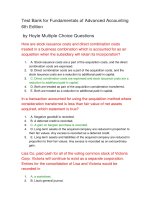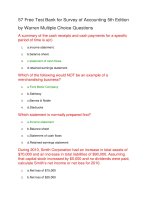Advanced accounting, 5th edition international student version ch10
Bạn đang xem bản rút gọn của tài liệu. Xem và tải ngay bản đầy đủ của tài liệu tại đây (645.81 KB, 51 trang )
10
10
Insolvency—
Insolvency Liquidation and
Reorganization
Advanced Accounting, Fifth Edition
Slide
10-1
Learning
Learning Objectives
Objectives
Slide
10-2
1.
Distinguish between a Chapter 7 and a Chapter 11
bankruptcy.
2.
Describe the five priority categories of unsecured claims and
list the order in which they are settled.
3.
Distinguish between a voluntary and involuntary bankruptcy
petition.
4.
Distinguish among fully secured, partially secured, and
unsecured claims of creditors.
5.
Describe contractual agreements that the debtor and its
creditors may enter into outside of formal bankruptcy
proceedings to resolve the debtor’s insolvent position.
6.
Describe the ways debt may be restructured in a
reorganization.
Insolvency
Insolvency
When a business becomes insolvent, it generally has
three possible courses of action:
1. Debtor and its creditors may enter into a contractual
agreement, outside bankruptcy;
2. Debtor or its creditors may file a bankruptcy petition,
after which the debtor is liquidated under Chapter 7 of
the Bankruptcy Reform Act; or
3. Debtor or its creditors may file a petition for
reorganization under Chapter 11 of the Bankruptcy
Reform Act.
Slide
10-3
Insolvency
Insolvency
Review:
True/False: Insolvency means that a debtor has
more current liabilities than current assets.
False
Slide
10-4
Contractual
Contractual Agreements
Agreements
A business that is unable to pay its obligations may
reach an accommodation with its creditors.
Possibilities generally include:
1. An extension of payment periods.
2. Composition agreements.
3. Formation of a creditors’ committee.
4. Voluntary assignment of assets.
Slide
10-5
LO 5 Contractual agreements.
Contractual
Contractual Agreements
Agreements
Extension of Payment Periods
FASB ASC paragraph 470-50-40-6
Provides that where a debt restructuring involves only
a modification of terms of payment, the debtor
should account for the restructuring prospectively
and not change the carrying amount of the payable,
unless the carrying amount exceeds the total future
cash payments of principal and interest specified by
the new terms.
No gain is recognized when the restructuring involves
an extension of the payment period only.
Slide
10-6
LO 5 Contractual agreements.
Contractual
Contractual Agreements
Agreements
Composition Agreements
(Creditors Accept Less Than Full Amount)
Creditors are often given some immediate cash
payment, and the amount of the remaining debts and
their interest rates are renegotiated.
Formation of a Creditors’ Committee
Committee is responsible for managing the debtor’s
business affairs for the period during which plans are
developed to rehabilitate, reorganize, or liquidate the
business.
Slide
10-7
LO 5 Contractual agreements.
Contractual
Contractual Agreements
Agreements
Voluntary Assignment of Assets
A debtor may elect to place its property under the
control of a trustee for the benefit of its creditors.
Any proceeds remaining after payment of the
creditors, are returned to the debtor.
Slide
10-8
LO 5 Contractual agreements.
Bankruptcy
Bankruptcy
Provisions of the Bankruptcy Reform Act apply to
individuals, corporations, and partnerships, as well
as to municipalities seeking voluntary relief from their
creditors.
A business unable to pay its obligations, may attempt
to negotiate with its creditors. If an agreement cannot
be reached, a legal petition for bankruptcy will be
initiated by either the
debtor (a voluntary petition) or its
creditors (an involuntary petition).
Slide
10-9
LO 3 Voluntary vs. involuntary
Bankruptcy
Bankruptcy
Voluntary Petitions
A debtor may file a voluntary petition with a
bankruptcy court for;
liquidation under Chapter 7 or for
reorganization under Chapter 11.
Filing a voluntary petition constitutes an order for
relief.
Slide
10-10
The bankruptcy petition (either voluntary or
involuntary) is an official form that initiates bankruptcy
proceedings and establishes an estate consisting of
the debtor’s assets.
LO 3 Voluntary vs. involuntary
Bankruptcy
Bankruptcy
Involuntary Petitions
Creditors initiate the action by filing a petition for
liquidation or reorganization with the bankruptcy
court.
The bankruptcy court will generally enter an order for
relief against the debtor only if evidence indicates that
the debtor, in fact, has not been paying its debts as
they become due.
Slide
10-11
LO 3 Voluntary vs. involuntary
Bankruptcy
Bankruptcy
Secured and Unsecured Creditors
Secured creditors are those whose claims are
secured by liens or pledges of specific assets.
If the proceeds from the sale of a pledged asset(s)
exceed the secured claim, the excess proceeds are
available for distribution to unsecured creditors.
Slide
10-12
LO 4 Secured and unsecured creditors.
Bankruptcy
Bankruptcy
Review:
True/ False: Voluntary bankruptcy petitions
may be filed under either Chapter 7 or
Chapter 11 of the Reform Act.
True
Slide
10-13
LO 4 Secured and unsecured creditors.
Bankruptcy
Bankruptcy
Review:
True/ False: Unsecured creditors with
priority will receive full satisfaction before
secured creditors are paid.
False
Slide
10-14
LO 4 Secured and unsecured creditors.
Liquidation
Liquidation (Chapter
(Chapter 7)
7)
A voluntary or involuntary petition for liquidation may
be filed under Chapter 7 of the Reform Act.
Upon filing, the bankruptcy court must decide whether
to accept or dismiss the petition.
Dismissals occur infrequently.
Debtor may dispute an involuntary petition.
If accepted,
an order for relief is entered and
the bankruptcy court will appoint an interim
trustee until a permanent trustee is selected.
Slide
10-15
LO 7 Chapter 1 versus Chapter 7.
Reorganization
Reorganization Under
Under Reform
Reform Act
Act
(Chapter
(Chapter 11)
11)
Creditors of an insolvent debtor may believe their
interests would be served by rehabilitating or
reorganizing the debtor.
In such a case:
Creditors and debtor may agree to a plan for
reorganization. or
Debtor or creditors may prefer to file with the
bankruptcy court a petition for reorganization
under Chapter 11 of the Reform Act.
Slide
10-16
LO 7 Chapter 1 versus Chapter 11.
Reorganization
Reorganization Under
Under Reform
Reform Act
Act
(Chapter
(Chapter 11)
11)
Fresh Start Accounting and Quasi
Reorganization
When firms emerge from bankruptcy, FASB ASC
paragraph 852-10-45-19 to 20 provides for fresh
start accounting.
Assets and liabilities are reported at fair values.
Beginning retained earnings is reported at zero.
Two conditions must exist:
Fair value of assets must be less than the post
liabilities and allowed claims, and
Slide
10-17
Original owners must own less than 50% of the
voting stock after reorganization.
LO 7 Chapter 1 versus Chapter 11.
Reorganization
Reorganization Under
Under Reform
Reform Act
Act
(Chapter
(Chapter 11)
11)
Fresh Start Accounting and Quasi
Reorganization
Quasi reorganization
Per FASB ASC 852- 10-45-20 three steps are required:
1. Authorization from creditors and stockholders is
required.
2. All assets are revalued to fair values with losses
recorded in retained earnings.
3. The deficit in retained earnings is eliminated by
charging to (reducing) paid-in capital.
Slide
10-18
LO 7 Chapter 1 versus Chapter 11.
Reorganization
Reorganization Under
Under Reform
Reform Act
Act
(Chapter
(Chapter 11)
11)
Accounting for Reorganization – Troubled
Debt
Debt may be restructured in any one (or a
combination) of the following methods:
1. The debtor may transfer assets in full
settlement of the payable.
2. The debtor may give an equity interest in its
firm in full settlement of the payable.
3. The creditor may modify terms of the payable.
Slide
10-19
LO 7 Chapter 1 versus Chapter 11.
Reorganization
Reorganization Under
Under Reform
Reform Act
Act
(Chapter
(Chapter 11)
11)
Accounting for Reorganization – Troubled
Debt
Transfer of Assets
A debtor that transfers assets to a creditor in full
settlement of a payable recognizes a gain.
The gain is measured by the excess of the carrying value
of the payable over the fair value of the assets
transferred.
Slide
10-20
The difference between the fair value and the carrying
amount of the assets transferred is a gain or loss and is
reported as a component of net income for the period of
transfer.
LO 7 Chapter 1 versus Chapter 11.
Reorganization
Reorganization Under
Under Reform
Reform Act
Act
(Chapter
(Chapter 11)
11)
Accounting for Reorganization – Troubled
Debt
Grant of an Equity Interest
A debtor that issues an equity interest in its firm to a
creditor in full settlement of a payable shall account for
the equity interest at its fair value.
Difference between the fair value of the equity interest
issued and the carrying amount of the payable is
reported as a gain on restructuring.
Debtor determines its gain based on undiscounted cash
flows.
Slide
10-21
LO 7 Chapter 1 versus Chapter 11.
Reorganization
Reorganization Under
Under Reform
Reform Act
Act
(Chapter
(Chapter 11)
11)
Accounting for Reorganization – Troubled
Debt
Modification of Terms
A debtor, in a troubled debt restructuring involving only
modification of terms of a payable, accounts for the
effects of the restructuring prospectively from the time
of restructuring.
The carrying value of the payable is not changed at the
time of restructuring unless the carrying value exceeds
the total future cash payments specified by the new
terms.
Slide
10-22
LO 7 Chapter 1 versus Chapter 11.
Reorganization
Reorganization Under
Under Reform
Reform Act
Act
(Chapter
(Chapter 11)
11)
Review:
True/False: In a reorganization involving a
transfer of assets, the debtor will recognize
a gain on restructuring measured by the
excess of the carrying value of the payable
settled over the book value of the assets
transferred.
False
Slide
10-23
LO 7 Chapter 1 versus Chapter 11.
Reorganization
Reorganization –– Transfer
Transfer of
of Assets
Assets
E10-3: Bar Company, which is in financial difficulty
and in the process of a voluntary reorganization, has
agreed to transfer to a creditor a copyright it owns in
full settlement of a $150,000 note payable and
$15,000 in accrued interest. The copyright, which
originally cost $100,000, has an accumulated
amortization balance of $55,000 and a current fair
value of $95,000.
Required:
a. Prepare the journal entries on Bar Company’s
books to record the transfer of the copyright.
Slide
10-24
LO 7 Chapter 1 versus Chapter 11.
Reorganization
Reorganization –– Transfer
Transfer of
of Assets
Assets
E10-3 a. Prepare the journal entries on Bar
Company’s books to record the transfer of the
copyright.
Copyright
50,000
Gain on Transfer of Assets
50,000
Revalue copyright to fair value. $95,000 – ($100,000 $55,000)
Notes Payable
150,000
Accrued Interest Payable
15,000
Accumulated Amortization – Copyright
Copyright ($100,000 + $50,000)
Slide
10-25
Gain on Debt Restructuring
55,000
150,000
70,000
LO 7 Chapter 1 versus Chapter 11.









